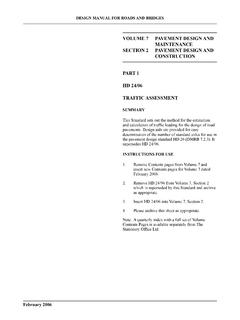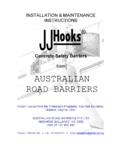Transcription of Joint Stewardship & Oversight Agreement - Connecticut
1 FHWA/CTDOT Stewardship Plan Joint Stewardship & Oversight Agreement Federal Highway Administration (FHWA) & Connecticut Department of Transportation November 23, 2010 FHWA/CTDOT Stewardship Plan FHWA/CTDOT Stewardship Plan Agreement BETWEEN THE FEDERAL HIGHWAY ADMINISTRATION AND THE Connecticut DEPARTMENT OF TRANPORTATION section 106 of Title 23, United States Code, requires that the Federal Highway Administration (FHWA) and the State (CTDOT) enter into an Agreement documenting the extent to which the CTDOT assumes the responsibilities of the FHWA under Title 23. Title 23 is simply a codified compilation of laws pertaining to highways passed over several bills and contains most laws that the FHWA and the CTDOT must comply with in the federal-aid highway program. The Stewardship and Oversight Agreement formalizes these delegated responsibilities and agreements to address how the Federal-aid highway program will be administered in the State.
2 Approvals that are delegated means that the CTDOT makes the approval on behalf of the FHWA following all normal requirements. Approvals that are not delegated means that the FHWA actually takes the approval action. Delegation has no impact on the actual requirements that must be met, simply who makes them. This plan explicitly identifies what approvals are needed and who performs them. There are program approvals (such as approval of a manual or procedure), and project specific approvals (such as approval of a specific contract). The Connecticut General Statutes, Volume 4, Titles 13, 13a and 13b, will be the controlling Laws under which this Stewardship Agreement will be exercised, including all the CTDOT directives and Commissioner s Administrative Memoranda. This Agreement does not preclude the FHWA access to and review of Federal-aid projects at any time, and it does not replace the fundamental provisions of law in Title 23 with respect to the basic structure of the Federal-aid program.
3 The FHWA will exercise its Stewardship and Oversight through product evaluations, program assessments, process reviews, continuous process improvement initiatives, program management activities, and other project involvement activities. The FHWA may at any time have access to and review project phases and records under this Agreement . In accordance with 23 CFR , records will be retained for a minimum of 3 years or until litigation, claims, or audit findings initiated before the expiration of the 3-year period have been resolved. Page | i TABLE OF CONTENTS Chapter Page INTRODUCTION .. 1 Performance Indicators .. 2 Approved Manuals, Standards, or Processes .. 5 PROJECT Oversight .. 9 Project Oversight Determination .. 9 Table 1: Project Oversight Determination Summary Project Development (Including Design and Contract Approval) .. 11 Table 2: Project Development/Approval Summary Project Construction.
4 14 Table 3: Construction Summary Local Public Agency (Municipalities) .. 16 Table 4: Project Development Oversight for Municipalities Summary Table 5: Project Construction for Municipalities Summary PROGRAM Stewardship .. 20 Process Review/Product Evaluation .. 20 Table 5: Review/Evaluation Program Summary Bridge Program .. 21 Table 6: Bridge Program Summary Civil Rights Program .. 23 Table 7: Civil Rights Program Summary Environment Program .. 25 Table 8: Environment Reviews Summary Table 9: Envirnmental Assessment Summary Table 10: Envirnomental Impact Statement Summary Table 11: section 4(f) Summary Table 12: section 106 Summary Table 13: Traffic Noise and Air Quality Summary Table 14: Threatened and Endangered Species Summary Table 15: Army Corps of Engineers section 404 Summary Table 16: State Wetland and Water-related Permits and Authorizations Summary Page | ii TABLE OF CONTENTS Continued Chapter Page Financial Management Program.
5 29 Figure 1: Project Flowchart Figure 2: FHWA Projects Contracts through Billing Flowchart Table 17: Financial Management Program Summary Intelligent Transportation Systems (ITS)/Operations Process .. 36 Figure 3: Intelligent Transportation Systems Process Table 18: ITS Process Summary Maintenance and Monitoring Program .. 42 Major Projects .. 43 Table 19:Major Projects Summary Pavement Design and Management Program .. 44 Table 20: Pavement Design and Management Summary Planning Program .. 45 Table 21: Planning Summary Quality Assurance Program for Materials .. 49 Table 22: Quality Assurance Program for Materials Summary Research, Development & Technology Program .. 50 Table 23: RD&T Program Summary Rights-of -Way Process .. 53 Table 24: R-O-W Process Summary Safety Program .. 55 Table 25: Safety Program Summary APPENDICES .. 59 APPENDIX A: LIST OF ACRONYMS .. 59 APPENDIX B: FHWA RISK ASSESSMENT PROCESS.
6 60 APPENDIX C: PROCUREMENTS .. 61 FHWA/CTDOT Stewardship Plan Page 1 INTRODUCTION In order to distinguish the term Stewardship from Oversight the following definitions will apply throughout this document: Stewardship : The efficient and effective management of the public funds that have been entrusted to the Federal Highway Administration. Oversight : The act of ensuring that the Federal highway program is delivered consistent with applicable laws, regulations and policies. Stewardship reflects our collective [Federal Highway Administration (FHWA) and Connecticut Department of Transportation (CTDOT)] responsibility for the development and implementation of the Federal-aid highway program. It involves all activities involved in delivering the Federal-aid highway program, such as leadership, technology deployment, technical assistance, problem solving, program administration and Oversight .
7 Oversight is the compliance or verification component of the FHWA s Stewardship activities. Narrowly-focused, Oversight activities ensure that the implementation of the Federal-aid highway program areas is done in accordance with the applicable laws, regulations, and policies. When the CTDOT assumes project approval responsibilities, it must have mechanisms in-place to assure that all project actions will be carried out according to laws, regulations, and policies. This applies to projects administered by the CTDOT or by local public agencies (LPA). These mechanisms would typically include processes, procedures, and program manuals. The FHWA must conduct verification activities to assure that the CTDOT or the LPA implementation of the Federal-aid highway program conforms with laws, regulations and policies as noted in this Agreement . The FHWA s Oversight and independent verification activities are similar to the quality assurance portion of quality control/quality assurance programs prevalent in many construction and materials programs.
8 This Agreement does not modify FHWA s non-Title 23 program Oversight and project approval responsibilities for activities such as required under the Clean Air Act; the National Environmental Policy Act of 1969 (NEPA) and other related environmental laws and statutes; the Uniform Relocation Assistance and Real Property Acquisition Policies Act of 1970; and the Civil Rights Act of 1964 and related statutes, unless expressly permitted by SAFETEA-LU section 6004 and 6005. FHWA/CTDOT Stewardship Plan Page 2 PERFORMANCE INDICATORS Currently, both the CTDOT and the FHWA collect and evaluate many performance measures. These performance measures change frequently, and the lists below only represent the performance measures at the time of approval of this Stewardship Plan. The performance indicators are an integral part of this Stewardship and Oversight Agreement . The Connecticut Department of Transportation (CTDOT) Performance Measures Program is managed by the Division of Transportation Infrastructure Performance Management in the Bureau of Policy and Planning ( ).
9 The performance measures report can be found on the CTDOT s Web site at The measures are reported quarterly and posted on the same website. Both agencies agree to use the performance measures to track and monitor the health of the Federal Aid Program. An evaluation of those performance measures will provide the tools to determine where changes should be made in the Oversight of projects, or where to focus our collective Stewardship . The indicators will also be used to gauge the effectiveness of the Federal-aid program in the State. Quarterly discussions between the FHWA and the CTDOT shall occur to review the trends of these measures and determine if attention or action needs to be refocused. Currently, the CTDOT performance measures include: Safety and Security Number of fatalities Number of fatalities related to impaired driving Percentage of fatalities related to impaired driving Number of fatalities per 100 million vehicle miles travelled Number of Injuries Number of Fatal Crashes Percentage of Seat Belt Use Number of motorcycle operator fatalities Number of motorcycle operator fatalities per 10,000 registered vehicles Number of Serious Crashes in Work Zones Number of CHAMP assistances Number of Oversize and Overweight Permits Customer Perception of Rail Safety (based on Metro North survey) Preservation International Roughness Index for state owned roads Pavement Serviceability Rating Number of Bridge Maintenance Memorandums Percent of Bridges rated Functionally Obsolete Percent of Bridges rated Structurally Deficient Bridge Condition Rating Categories for Highways (0-9)
10 Bridge Condition Rating Categories for Railroads (0-9) Average Age of Transit Fleet Mean Distance between Failures (Rail) Mean Distance between Failures (Bus) FHWA/CTDOT Stewardship Plan Page 3 Efficiency and Effectiveness Rail Ridership in millions of passengers On-Time Performance for Commuter Rail Bus Ridership in millions of passengers On-Time Performance for Bus Rail Freight Tonnage Air Freight Tonnage Enplaned Passengers Debt per Enplaned Passengers Total Expenditures Number of Positions, filled and vacant Quality of Life Tons recycled (demolition debris, steel, wood) Congestion Capacity of Connecticut Roads (over capacity, approaching capacity, under capacity) Average incident duration Average incident response time Accountability and Transparency Percent of agreements executed in under 60 days Percent of Construction Contracts Awarded within 60 days of Bid Opening Number of Project Closeouts Construction Projects On-Time Construction Projects On-Budget In addition, the FHWA has the following Dashboard items which are kept current in our Shared Unit Performance Plan System.














